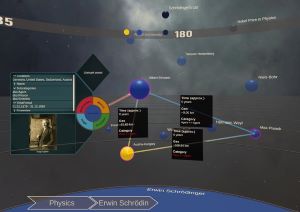Who Did What When? Discovering Complex Historical Interrelations in Immersive Virtual Reality

Traditional digital tools for exploring historical data mostly rely on conventional 2D visualizations, which often cannot reveal all relevant interrelationships between historical fragments (e.g., persons or events). In this paper, we present a novel interactive exploration tool for historical data in VR, which represents fragments as spheres in a 3D environment and arranges them around the user based on their temporal, geo, categorical and semantic similarity. Quantitative and qualitative results from a user study with 29 participants revealed that most participants considered the virtual space and the abstract fragment representation well-suited to explore historical data and to discover complex interrelationships. These results were particularly underlined by high usability scores in terms of attractiveness, stimulation, and novelty, while researching historical facts with our system did not impose unexpectedly high task loads. Additionally, the insights from our post-study interviews provided valuable suggestions for future developments to further expand the possibilities of our system.
@INPROCEEDINGS{10316480,
author={Derksen, Melanie and Becker, Julia and Elahi, Mohammad Fazleh and Maier, Angelika and Maile, Marius and Pätzold, Ingo and Penningroth, Jonas and Reglin, Bettina and Rothgänger, Markus and Cimiano, Philipp and Schubert, Erich and Schwandt, Silke and Kuhlen, Torsten and Botsch, Mario and Weissker, Tim},
booktitle={2023 IEEE International Symposium on Mixed and Augmented Reality (ISMAR)},
title={{Who Did What When? Discovering Complex Historical Interrelations in Immersive Virtual Reality}},
year={2023},
volume={},
number={},
pages={129-137},
doi={10.1109/ISMAR59233.2023.00027}}

